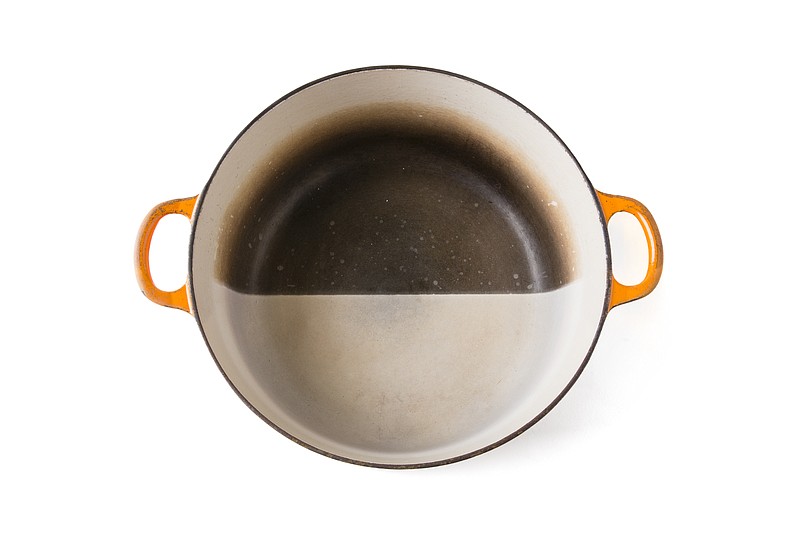Based on my reader mail, my cookware columns are stirring up controversy in the kitchen. Here I thought last year's mattress series crossed the threshold, but how folks feel about their slumber surfaces pales next to the practically umbilical attachment they have to their pans.
Home chefs have come out swinging skillets, defending them to their copper cores. I now know that if some of you had to choose between your eight-inch Teflon omelet pan and your mate, well, you don't have to, thank goodness. And while I do not want to come between you and that 20-piece set of nonstick cookware you bought in 1972 during a K-Mart blue-light special, I would like you all to please simmer down. We can get through this as friends.
In case you missed the frying pan fracas, two weeks ago I covered the pros and cons of common pan materials: aluminum, stainless steel, cast iron, carbon steel, copper and combinations. Last week, I shared the four essential pans every kitchen should have. I got the scoop straight from Lisa McManus, executive editor for America's Test Kitchen reviews, who can take the heat.
Some of you, including my husband, haven't forgiven me for the fact that since I started writing on this topic, someone in your house whom we shall not name ran out and spent the equivalent of a nice weekend away on new cookware.
Now, I am jumping from the frying pan into the fire with advice on how to care for said cookware. I figured, the least I can do is make this investment last the rest of your life.
"Relationships have ended after one partner put an expensive pan in the dishwasher," McManus warned.
So that doesn't happen in your house, follow these relationship-preserving tips to make sure your good cookware and relationship last:
◼️ Hand wash. Putting pans in the dishwasher will accelerate their demise, and could warp them. Though a cookware maker may say pans are dishwasher safe, dishwashers are harsh environments, said McManus, who recommends handwashing.
◼️ Cool it. Do not rush your hot pan into cold water. Thermal shock is hard on metal and could warp pans and shorten their lives.
◼️ Embrace the grunge. Pans are not décor items. Cookware that looks used is a badge of honor. "You don't want the carpenter with the hammer that looks brand new; you want one with beat-up tools," she said. Although the brownness left from burnt-on oil is not bad, if you want to restore some original shine, mix Barkeeper's Friend with water to make a paste, and scour.
◼️ Stained enamel? Though enamel-coated pans won't acquire seasoning like cast iron, their light surfaces can darken. To restore them, make a solution of one-part bleach and three parts water and let the mixture soak in the pan overnight.
◼️ The beauty of stainless-steel pans, which often have a core of aluminum, is their durability. Handwash them with soap, scrub all you want with a plastic scrubber (steel ones can scratch the surface), and if you need to soak them, go ahead.
◼️ Cast iron and carbon steel need seasoning, which means creating a coating of oil and fat, so when the pan heats, it has a naturally nonstick surface. For pans that don't come pre-seasoned, or that need re-seasoning, here's one way to do it: Wash pan in warm water. Let dry completely. Spread a thin layer of melted shortening or oil over it. Put it in a 400-degree oven on a rack upside down. Put a baking sheet underneath to catch drips. Bake for one hour. Let cool and wipe.
◼️ Don't use soap. When washing cast iron or carbon steel pans, let them cool a few minutes, and turn the tap on hot. Rinse and scrub with a brush or plastic scrubber, no soap. Soap will strip all the seasoning you are working hard to lay down. Don't worry about germs. The heat will kill them.
◼️ Don't soak. If food is stuck on, use boiling water to loosen it. Rinse, dry and set it back on the warm burner to finish drying. While you can let a stainless-steel pan soak overnight, soaking cast iron or carbon steel breaks down the oils you want to preserve.
◼️ Add seasoning. Once the pan is dry, add a drop of any kind of oil, about half the size of a dime. Wipe it all over the pan until the oil disappears. If your pan ever feels sticky or gummy, it has too much oil. Then you will need to use soap to get the gunk off, and re-season.
◼️ Lose the shine. Carbon steel pans usually arrive shiny and silver, but not for long. With use and seasoning, they turn blotchy brown and eventually black. Because these pans arrive coated with beeswax or industrial grease to prevent rusting, you need to scrub this coating off before seasoning. Rust is okay. If your cast iron or carbon steel pans get rusty, no problem. "People over-complicate this. If you mess up, just scrub the pan and start over. You can't hurt these pans. They are very forgiving."
Bon Appetit!
Syndicated columnist Marni Jameson is the author of five home and lifestyle books, including "Downsizing the Family Home – What to Save, What to Let Go" and "Downsizing the Blended Home – When Two Households Become One."
